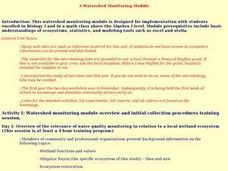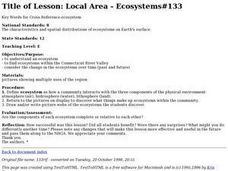Curated OER
Critical Habitat
Learners watch the video clip and create a web map showing the cycle between producers, consumers and decomposers. They also tell why it is important to conserve the old-growth forests.
Curated OER
Mental Map Postcard
Pupils visit an outdoor setting and make a mental map of what they observe. They return to the classroom and create a postcard with specified elements such as a description of the land and the ecosystem. Students illustrate the postcard.
Curated OER
Food Webs in the Bay
Students get acquainted with a type of ecosystem and how different organisms of that ecosystem compete with one another for resources. They analyze the submerged aquatic vegetation of a bay ecosystem. Students study plants.
Curated OER
Biodiversity Bird Hunt
Learners examine the influence of biodiversity on human culture through the use of birds. They brainstorm words that come to mind when they think of human cultures. They describe ways that human culture and biodiversity are linked.
Curated OER
Animal Habitats
Students study the word habitat and its meaning. They also identify that in order for something to be classified as a habitat there needs to be the proper shelter, food, water, and space.
Curated OER
Are You Being Poisoned by Your Dishes?
Students explore lead poisoning and how it relates to ceramic dishes. They perform an experiment to discover if any of your ceramic ware is leaching lead which might cause lead poisoning.
Curated OER
Leaves
Students explore, observe, and collect leaves from outside. They make journal entries, discuss the differences and common features of leaves and what function leaves serve. They will discuss the plant and tree leaves. Students draw...
Curated OER
Making a Food Web and Learning About Ecosystems
Third graders examine the difference between a food web and food chain. They also examine the importance of the sun in a food web and food chain. Students understand what happens when you remove parts of the chain.
Curated OER
Gwynns Falls
Students investigate the question: What is the impact of urban development and expansion on the health of a decidious forest ecosystem and humans? They examine the issue of land development by responding to a specific scenario and...
Curated OER
ECOLOGICAL BIOASSAY OF COPPER SULFATE IN DAPHNIA MAGNA
Students use this lab as a follow up to the introduction of the ecosystems and productivity levels, bioassays and what and how they measure, and Daphnia magna as an index organism, i.e., a species whose health within an ecosystem...
Curated OER
The Consequences of Extinction
Students participate in a class discussion on site of an older style bridge to help connect the significance of each organism in an ecosystem by using an analogy of bolts slowly being removed from a working bridge.
Curated OER
Invasive Species
Students use the Internet to research non-native plants that exist in their local community. Using this information, they analyze the invasive species effect on their environment. In groups, they plan and execute their own project to...
Curated OER
Deserts KWL Chart
Students will define what a desert is through the creation of a KWL Chart. This will help students to tap prior knowledge and make new connections with the new curriculum being delivered in the lesson.
Curated OER
Topical Ecosystems
Fourth graders read about two tropical ecosystems: the rainforest and the coral reef using Palm Reader. They then complete a study guide as part of their reading experience and create a Sketchy and PiCoMap as directed. Students take test...
Curated OER
A Watershed Monitoring Module
Students explore the relevance of water quality monitoring in relation to a local wetland ecosystem. They conduct standard water quality tests using wet tests and CBL calculators and probes. Student record and interpret the results.
Curated OER
Where in the World is..?: An ecological study
Students analyze different ecosystems from the perspective of someone from another planet. They compare different ecosystems to determine which would be suitable to inhabit. This is an interdisciplinary activity.
Curated OER
Rain Gardens for Controlling Excess Runoff
Students address the idea that human beings live within the world' ecosystems. They discuss how humans modify ecosystems as a result of population growth, technology, and consumption. Students discuss how the human destruction of...
Curated OER
The Effect of Medications on Daphnia
Students explore how human beings affect the world's ecosystem by examining the affects of medication on daphnia, a small freshwater organism very sensitive to pollution. Students use a computer model to repeat the experiment and analyze...
Curated OER
Daphnia and Algae: A Study of Pond Dynamics
Students observe interrelationships and interdependencies of organisms which may generate stable ecosystems. They also study that living organisms have the capacity to produce infinite sized populations, but environments and resources...
Curated OER
Fish In The Web of Life
Learners will develop skills of fish identification, correlate habitat characteristics with species present, develop a working vocabulary of Oneida fish terminology and fish names and discuss the relationship between a healthy ecosystem...
Curated OER
BIOME VIDEO Exchange Project
Pupils videotape information about the biome in which they live without naming it and send this to other students across the nation so they can guess which biome it comes from. Pupils include local ecosystems, information concerning...
Curated OER
Bats in My Backyard
Students investigate the importance of bats in the ecosystem and develop an understanding of the effect that humans have on bat populations. They research bats by reading articles while focusing understanding scientific writing. They...
Curated OER
Local Area - Ecosystems
Students examine ecosystems in the Connecticut River Valley. They view and discuss photos of ecosystems within their community, and create a picture web of an ecosystem.
Curated OER
Does a change in pH affect the growth and survival rate of aquatic plants?
Learners determine if changes in pH affect the growth and survival rates of aquatic plants. They evaluate the optimal pH levels for the growth of aquatic plants.

























